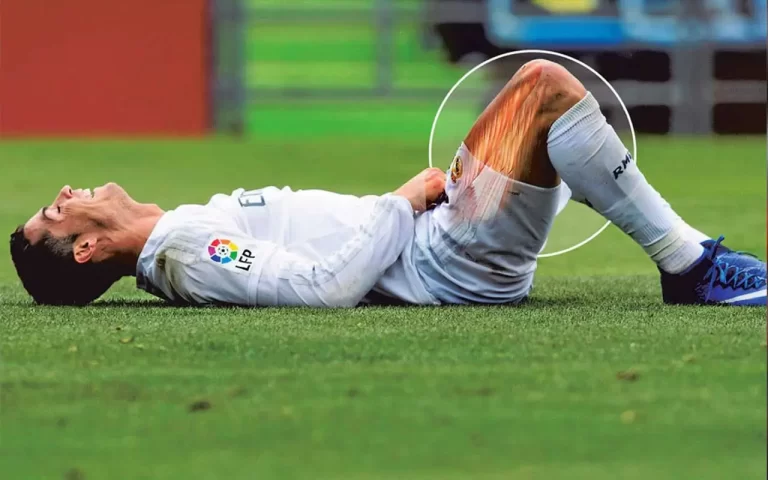Torn Pec Recovery Time, Symptoms and Treatment Without Surgery

Causes Of Torn Pec Recovery
Torn Pec recovery, also known as pectoralis major tears, are often caused by sudden and forceful movements. Common activities that can lead to a pec tear include weightlifting, bench pressing, and contact sports. These activities place a significant amount of stress on the chest muscles, increasing the risk of injury.

Additionally, age and previous injuries can also contribute to the likelihood of experiencing a pec tear. As we age, our muscles tend to weaken, making them more susceptible to tears. Similarly, individuals who have previously experienced a pec tear are at a higher risk of re-injury. It is important to note that pec tears aren’t considered permanent injuries. With proper treatment and rehabilitation, most individuals are able to regain full strength and function in their pec muscles.
Pec Tear
A pec tear, also known as a pectoralis major tear, is a common sports injury that affects the chest muscles. The pectoralis major is the large muscle group located in the chest region, which plays a vital role in several upper body movements such as pushing and lifting. When this muscle is subjected to excessive stress or strain, it can tear partially or completely, resulting in a pec tear.
Can a pec tear heal on its own? Unfortunately, a complete pec tear is unlikely to heal on its own without medical intervention. Unlike some muscle strains that can heal with rest and conservative treatments, a complete tear of the pectoralis major typically requires surgical repair. It is essential to seek proper medical attention as soon as possible to ensure a proper diagnosis and appropriate treatment plan for a pec tear.
Symptom of a Tear
Symptoms of a pec tear typically manifest as immediate pain and a sensation of tearing in the chest area. Individuals may also experience swelling, bruising, and tenderness in the affected area. Movements requiring the use of the chest muscles, such as pushing or lifting heavy objects, may exacerbate the pain. It is important to note that the severity of the symptoms can vary depending on the extent of the tear.

How long does a torn pec recovery take to heal? The recovery time frame for a pec tear can vary depending on several factors, including the severity of the tear, the individual’s overall health, and the treatment approach taken. In general, it can take several weeks to several months for a torn pec muscle to fully heal. However, it is crucial for individuals to follow their healthcare provider’s guidance and engage in proper rehabilitation exercises to optimize the healing process and minimize the risk of re-injury.
Recover The Muscle
After sustaining a pec tear, the primary goal is to repair the damaged muscle to restore strength and functionality. The rehabilitation process typically includes a combination of rest, physical therapy, and possibly surgical intervention depending on the severity of the tear. For Grade 1 pec tears, which are the least severe, conservative treatment is often sufficient. This involves immobilization, such as wearing a sling or brace, to allow the muscle to heal properly.
Physical therapy exercises are gradually introduced to improve flexibility, range of motion, and strengthen the surrounding muscles. The recovery time for a Grade 1 pec tear can vary, but on average, it takes about 6 to 8 weeks for the muscle to heal completely. However, it is important to keep in mind that individual recovery times may vary based on factors such as age, overall health, and adherence to the rehabilitation program.
In cases where the pec tear is more severe, surgery may be required to repair the muscle. This is often recommended for Grade 2 and Grade 3 tears, which involve partial or complete muscle rupture, respectively. Surgical repair involves reattaching the torn muscle to its insertion point using sutures or anchors. Following surgery, a strict rehabilitation plan is implemented to restore strength and function.
This typically includes a period of immobilization, followed by progressive physical therapy exercises and strength training. The recovery time for Grade 2 and Grade 3 tears can be significantly longer, ranging from several months to a year, depending on the extent of the injury and individual response to treatment.
Torn Pec Recovery Symptoms and Treatment
While a torn pec muscle can be a painful and debilitating injury, early recognition of symptoms can lead to prompt treatment and a successful recovery. Common symptoms of a torn pec include sharp pain in the chest, particularly when using the arm or attempting movements such as pushing or lifting. Swelling, bruising, and a visible indentation or gap in the muscle can also be observed.

It is important to note that attempting to run or engage in strenuous activities with a torn pec recovery isn’t advisable as it can worsen the injury and lead to further complications. When it comes to the treatment of a torn pec muscle, the first step is typically to rest and avoid activities that aggravate the injury. Applying ice packs and taking over-the-counter pain medications can help to reduce swelling and provide temporary relief.
Physical therapy with a trained professional can play a crucial role in the rehabilitation process, focusing on strengthening the surrounding muscles, improving range of motion, and promoting healing. In severe cases where conservative measures fail, surgery may be necessary to repair the torn muscle. However, it is always advisable to consult with a healthcare professional for a proper diagnosis and personalized treatment plan.
Pec Muscle Tear Symptoms
A torn pec muscle, also known as a pectoralis major tear, can result in significant discomfort and limited mobility. This type of injury is predominantly seen in athletes who participate in activities that involve repetitive pushing or heavy lifting, such as weightlifting, rugby, or wrestling. The severity of a pec muscle tear can vary, with some cases being more serious than others.
Is a pec tear serious?
Absolutely. The individual experiencing this injury may notice visible swelling and bruising in the chest area, accompanied by intense pain. In some cases, there may be a noticeable deformity or bulge in the muscle due to the torn fibers. Additionally, the affected side may feel weak, leading to difficulties in performing everyday tasks such as lifting objects or even pushing oneself back up from a seated position. Prompt medical attention is crucial to assess the extent of the injury and determine the appropriate treatment plan.
Pec Tear Recovery Time Frame
Pec Tear Recovery Time Frame depends on the severity of the injury and the individual’s adherence to rehabilitation protocols. A Grade 1 pec strain, which is the mildest form of a torn pec muscle, typically takes around 2-4 weeks to heal. During this time, it is essential to avoid any activities that may aggravate the injury and to focus on rest, ice, compression, and elevation (RICE).

For more severe pec tears, such as Grade 2 and Grade 3, the recovery time frame can range from 4-12 weeks or longer. Grade 2 tears involve partial tearing of the muscle fibers, while Grade 3 tears involve a complete rupture. In these cases, surgical intervention may be necessary to repair the muscle and restore its function. Following surgery, a comprehensive rehabilitation program, supervised by a qualified healthcare professional, is crucial to optimize recovery and prevent complications.
Pec Major Injuries are Graded by Severity
What distinguishes a grade 3 pec tear from lower grades is the severity of the tear and the extent of damage to the muscle fibers. In grade 3 tears, resulting in a greater degree of pain, bruising, and swelling. Range of motion of the shoulder joint may be severely compromised, and there may even be a noticeable deformity or bulging of the muscle.
Treatment for a grade 3 pec tear typically requires surgical intervention to repair and reattach the muscle, followed by a prolonged period of rehabilitation and physical therapy to regain strength and function in the affected arm.
Grade 3 pec tears are the most severe type of pec major injuries. They occur when the muscle is completely ruptured or torn away from its attachment point on the humerus bone. This type of tear often involves a significant loss of strength and function in the affected arm, making it difficult to perform even simple tasks.
Physio Help
For individuals who have suffered a pec tear, seeking the guidance of a physiotherapist can be incredibly beneficial in the recovery process. Physiotherapy aims to help patients regain strength, mobility, and functionality in their injured muscles. While surgery may be necessary for severe cases, not all pec tears require invasive measures.
A physiotherapist will conduct a thorough assessment and evaluation to determine the extent of the pec tear and create a personalized treatment plan accordingly. Through targeted exercises, manual therapy, and other modalities, they can help patients regain strength and mobility in their injured muscle. Additionally, physiotherapy can aid in reducing pain, improving posture, and preventing further injuries. Overall, seeking the expertise of a qualified physiotherapist can greatly enhance the recovery process and improve long-term outcomes.
Anatomy and Function
The pectoralis major muscle, commonly referred to as the pecs, is a large muscle in the chest region. It is responsible for several important functions, including shoulder movement, arm flexion, and stabilization of the shoulder joint. This muscle is divided into 2 main parts: the clavicular head, which originates from the collarbone, and the sternal head, which originates from the sternum.
When it comes to pec tears, it is essential to understand that they can occur at different stages. A Stage 1 pec tear, also known as a mild tear, involves damage to a few muscle fibers. This type of tear is accompanied by minimal pain and may not significantly affect the muscle’s strength or function. However, it is crucial to address a Stage 1 pec tear promptly to prevent it from progressing to a more severe injury. Awareness of the anatomy and function of the pectoralis major muscle aids in understanding the impact of different types of pec tears and guides in determining the appropriate course of treatment.
Torn Pec Muscle Occurs
A torn pec muscle, also known as a pectoralis tear, is a result of excessive strain or trauma to the chest muscles. This can happen during weightlifting exercises such as bench press, push-ups, or lifting heavy weights. It is important to note that the severity of the tear can vary, with a Type 2 pec tear being one of the more common classifications.

When a Type 2 pec tear occurs, it means that the muscle has partially torn in the middle, resulting in a significant loss of strength and function. This type of tear often happens when there is a sudden and forceful contraction of the muscle, such as when trying to lift an extremely heavy weight. The strain can be overwhelming for the muscle fibers, leading to the tear. Understanding how this type of tear occurs is crucial in determining the most appropriate treatment and recovery plan for individuals experiencing this injury.
Make a Diagnosis of a Torn Pec Muscle
To make a diagnosis of a torn pec muscle, a thorough physical examination is essential. The physician will begin by evaluating the patient’s medical history, including any previous injuries or conditions that may have contributed to the current muscle tear. The next step involves a careful assessment of the affected area, looking for signs of swelling, bruising, or deformity. The physician will also palpate the surrounding muscles and bones to identify any abnormalities or areas of tenderness.
In addition to the physical examination, imaging tests are often used to confirm the diagnosis of a torn pec muscle. X-rays can help rule out any fractures or other bone injuries, while ultrasound imaging can provide detailed pictures of the soft tissues, including the torn muscle fibers.
Magnetic resonance imaging (MRI) scans can also be utilized to visualize the extent and location of the tear, allowing for a more accurate diagnosis. By combining these diagnostic approaches, healthcare professionals can confidently identify a torn pec muscle and determine the most appropriate treatment plan for each individual patient.






